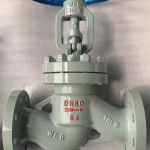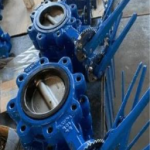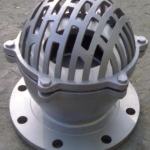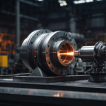Types of Control Valves & Their Working Principles
Control valves form the centre of any flow control system. Control valves regulate the fluid flow—liquids, gases, or steam—by modifying the size of the passage of the fluid according to a signal from a controller. Control valves play an essential role in pressure, temperature, and fluid level regulation in industrial processes.
Here at SVR, we have always believed that it is extremely important to have a grasp on the different control valves and the way they operate in order to design responsive, safe, and efficient systems. In this complete blog, we dissect the most common control valves, discuss the way they operate, and take you through how to select the appropriate valve for your application.
What Is a Control Valve?
A control valve is a device which is used to regulate the fluid flow as per the signal from the controller. It consists of three integral components:
- Actuator – Translates in moving the disc or valve plug.
- Positioner – Causes the valve to travel to a specific position.
- Valve Body – It contains the closure element and flow path.
The controller sends a signal (electric or pneumatic) to the actuator, which opens the valve for desired process parameters.
Control valves are crucial in industries such as:
- Oil & Gas
- Chemical processing
- Power generation
- Water treatment
- HVAC systems
Functions of a Control Valve
Control valves serve several important functions in industrial systems:
- Regulate Flow Rate: Vary the fluid flow to meet process requirements.
- Maintain Pressure Levels: Assist in maintaining steady pressure by opening or closing in accordance with changes.
- Control Temperature: Through the regulation of heating or cooling fluids’ flow.
- Ensure System Safety: Avoid overpressure and reduce mechanical wear.
- Support Automation: Be a central component in closed-loop control systems.
Types of Control Valves:
There are numerous types of control valves, but depending on the operation method, the two fundamental types are:
- Pneumatic Control Valve
- Electric Control Valve
Compressed air is utilized to drive the valve actuator in pneumatic control valves. They find extensive application in process industries owing to their quick response and explosion-proof feature.
Working Principle:
- A controller provides a signal (typically 3-15 PSI or 0.2-1 bar) to the pneumatic actuator.
- The actuator positions the valve stem or plug according to the received pressure.
- The positioner guarantees that the valve reaches the correct position.
- The valve modulates to hold the setpoint (flow, pressure, etc.).
- Pneumatic valves can employ diaphragm, piston, or spring-return actuators.
Benefits of Pneumatic Control Valve:
- Quick response to control signals
- Fail-safe design: Springs provide return to safe position upon air failure
- Explosion-proof: No electric power involved
- Lower initial price than electric versions
- Robust in hostile environments
Electric control valves utilize electric actuators (motors) to drive the valve. These are becoming increasingly common in automatic systems where high precision and slow modulation are desired.
Working Principle:
- A control system provides an electrical signal (usually 4-20 mA or digital signal) to the electric actuator.
- The actuator drives a motor to drive the valve stem.
- A positioner or control board controls precise valve positioning.
- The valve modulates or moves to open/close position as commanded.
- These valves are ideal for remote control and PLC, SCADA, and IoT-based integration.
Benefits of Electric Control Valve:
- High precision control over valve positioning
- Compressed air not required – lowers infrastructure cost
- Quiet operation with less vibration
- Ideal for remote or hard-to-reach places
- Energy efficient in long-term applications
Pneumatic vs Electric Control Valves – Key Differences:
| Feature | Pneumatic Control Valve | Electric Control Valve |
| Actuation Source | Compressed Air | Electric Power (AC or DC) |
| Response Time | Faster | Slightly slower |
| Control Precision | Good, depends on positioner | High precision with digital control |
| Installation Cost | Lower (if air supply exists) | Higher initial cost |
| Maintenance | Requires air system upkeep | Requires motor maintenance |
| Suitability for Hazardous Areas | Very suitable due to no sparks | Needs explosion-proof motors |
| Energy Usage | Continuous air usage | Power used only during operation |
| Common Use Cases | Oil & Gas, Refineries, Chemical Plants | HVAC, Food Processing, Water Plants, Pharma |
Uses of Control Valve:
Pneumatic Valves: Use in high-speed, high-pressure applications with fail-safe operations as a priority, like refineries, petrochemical factories, and power plants.
Electric Valves: Best suited for remote control, digital process control, and clean environments like food and drinks factories, data centres, and intelligent buildings.
Benefits of Control Valve Usage
Whether electric or pneumatic, control valves have several operational advantages:
Better Process Control:
Precisely control flow and pressure in real time.
Increased Safety:
Automatically react to pressure spikes or equipment malfunction.
Reduced Downtime:
Automatic control minimizes the need for human intervention and mistakes.
Cost Efficiency:
Optimize energy and resource consumption, reducing operational costs.
Easy Integration:
Electric valves provide easy integration with SCADA, PLC, and new-generation automation platforms.
How to Choose Between Pneumatic and Electric Valve?
The choice between the two is based on many factors:
- Environment: Select pneumatic for hazardous or flammable settings.
- Precision Needs: Electric valves provide more control precision.
- Infrastructure: Utilize what you have on hand—air or power.
- Speed vs Accuracy: Pneumatic provides speed; electric provides precision.
- Budget: Pneumatic valves tend to be less expensive in the short run.
Why Select SVR?
At SVR Company, we are dedicated to providing high-performance control valves engineered for precision, reliability, and long service life. Here’s why we’re the go-to choice:
Our Strengths:
- ISO-certified manufacturing process
- Robust electric and pneumatic control valve designs
- Global shipping and after-sales support
- Custom-engineered valves for unique flow conditions
- 24/7 customer support and technical guidance
- Material variety: Stainless steel, cast iron, brass, and more
Whether you need a valve for water treatment, industrial automation, or energy systems, SVR has the expertise to deliver exactly what you need.
Conclusion
Control valves are critical to the accurate operation of contemporary industrial systems. Although pneumatic control valves provide speed and reliability, electric control valves are unmatched in terms of precision and integration with intelligent automation platforms. By knowing how they work and differ, you can choose the appropriate valve for your application.
SVR provides both forms with quality guarantee, worldwide distribution, and unrivaled experience.
Call us today for expert guidance and dependable valve products customized to meet your industry requirements.











